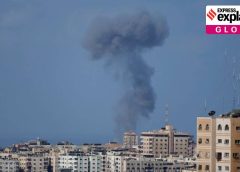
Explained: The ongoing violence in Gaza between Israel and Palestine
[ad_1]
Israel and Palestinian militants in the Gaza Strip were exchanging fire Saturday, in the worst bout of cross-border violence since an 11-day war between Israel and Hamas last year. Israeli airstrikes have killed 11 people, including a senior commander from the Palestinian Islamic Jihad, an Iran-backed militant group, who was slain in a targeted attack.
Israel has carried out several deadly airstrikes, among them the targeted killing of a senior commander from the Palestinian Islamic Jihad, an Iran-backed militant group. Militants have fired dozens of rockets at Israeli cities and towns, disrupting life for tens of thousands of people. Here’s a look at the latest round of violence.
In Hamas’s Shadow
Islamic Jihad is the smaller of the two main Palestinian militant groups in the Gaza Strip and is vastly outnumbered by the ruling Hamas group. But it enjoys direct financial and military backing from Iran and has become the driving force in engaging in rocket attacks and other confrontations with Israel.
Hamas, which seized control of Gaza in 2007 from the internationally recognised Palestinian Authority, is often limited in its ability to act because it bears responsibility for running the day-to-day affairs of the impoverished territory. Islamic Jihad has no such duties and has emerged as the more militant faction, occasionally even undermining Hamas’ authority.
The group was founded in 1981 with the aim of establishing an Islamic Palestinian state in the West Bank, Gaza and all of what is now Israel. It is designated a terrorist organisation by the US State Department, European Union and other governments. Like Hamas, Islamic Jihad is sworn to Israel’s destruction.
The Iranian Connection
Israel’s archenemy Iran supplies Islamic Jihad with training, expertise and money, but most of the group’s weapons are locally produced. In recent years, it has developed an arsenal equal to that of Hamas, with longer-range rockets capable of striking central Israel’s Tel Aviv metropolitan area.
Air raid sirens went off in the suburbs just south of Tel Aviv on Friday, although no rockets appear to have hit the area. Although its base is Gaza, Islamic Jihad also has leadership in Beirut and Damascus, where it maintains close ties with Iranian officials. Ziad al-Nakhalah, the group’s top leader, was in Tehran meeting Iranian officials when Israel began its operation in Gaza on Friday.
Targeting Commanders
This isn’t the first time Israel has killed Islamic Jihad leaders in Gaza. The commander it killed Friday, Taiseer al-Jabari, replaced Bahaa Abu el-Atta – who was slain by Israel in a 2019 strike. His death had been the first high-profile assassination of an Islamic Jihad figure by Israel since the 2014 war in the Gaza Strip.
Al-Jabari, 50, was a member of Islamic Jihad’s “military council,” the group’s decision-making body in Gaza. He was in charge of the Islamic Jihad militant activities in Gaza City and the northern Gaza Strip during the 2021 war. Israel said Al-Jabari was preparing to launch an anti-tank missile attack against Israel.
His death came on the heels of the arrest by Israel of a senior Islamic Jihad commander in the West Bank, earlier this week. Bassam al-Saadi, 62, is a senior Islamic Jihad official in the northern West Bank. According to Israeli media, al-Saadi was working to deepen the group’s reach in the West Bank and expand its capabilities.
Al-Saadi spent a total of 15 years over several stints in Israeli jails for being an active Islamic Jihad member. Israel killed two of his sons who were also Islamic Jihad militants in separate incidents in 2002 and destroyed his home during a fierce battle in the West Bank city of Jenin the same year. “Once you will hit the commanders it will affect immediately all the organization,” said Zvika Haimovich, the former head of the Israeli military’s air defence force.“It immediately creates a big mess in the Jihad.”
A Delicate Balance
Since seizing power in 2007, Hamas has fought four wars with Israel, often with support from Islamic Jihad fighters. Aside from a flare-up earlier this year, the border has largely been quiet since last year’s 11-day war and Hamas appears to be staying on the sidelines of this current conflagration, which might keep it from spilling over into all-out war.
Islamic Jihad militants have challenged Hamas by firing rockets, often without claiming responsibility, to raise its profile among Palestinians while Hamas maintains the cease-fire. Israel holds Hamas responsible for all rocket fire coming from Gaza. Hamas must walk a tightrope between restraining Islamic Jihad’s fire at Israel while avoiding the ire of Palestinians if it cracks down on the group. Like in past flare-ups, Hamas will have the final say in how long — and how violent — this round of fighting will last.
Caretaker Leader
The current fighting comes as Israel is mired in a protracted political crisis that is sending voters to the polls for the fifth time in less than four years in the fall. Caretaker leader Yair Lapid took over earlier this summer after the ideologically diverse government he helped form collapsed, triggering the new elections.
Lapid, a centrist former TV host and author, lacks the security background many Israelis see as essential for their leadership. His political fortunes could rest on the current fighting, either gaining a boost if he can portray himself as a capable leader or taking a hit from a lengthy operation as Israelis try to enjoy the last weeks of summer. Lapid hopes to edge out former Prime Minister Benjamin Netanyahu, a security hawk who is on trial for corruption charges, in the upcoming vote.
[ad_2]
Source link


